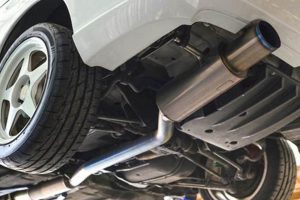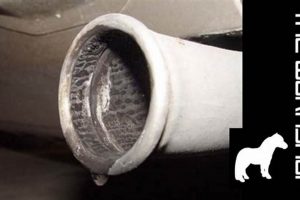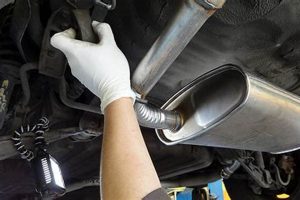The process of joining metal components of an automotive exhaust noise reduction device via fusion is a common repair procedure. This technique typically involves the application of intense heat to melt and fuse the metal of the exhaust component and a filler material, creating a strong bond. A typical example involves fixing a hole or crack in the exhaust system to prevent leaks and maintain optimal vehicle performance.
Addressing damage in this part of a vehicle’s exhaust system is critical for several reasons. A properly functioning system contributes to reduced noise pollution, improved engine efficiency, and the prevention of harmful emissions. Historically, these repairs have been essential for maintaining vehicle compliance with environmental regulations and ensuring a comfortable driving experience. A damaged system can lead to increased engine strain, decreased fuel economy, and potentially dangerous exhaust fumes entering the vehicle cabin.
The following sections will delve into the specific methods employed, required safety precautions, material considerations, and common challenges encountered during exhaust system maintenance and repair.
Essential Considerations for Exhaust System Repair
The following guidance provides essential considerations for performing effective and durable exhaust system repairs, minimizing potential complications and maximizing longevity.
Tip 1: Material Compatibility: Ensure that the filler metal used is compatible with the base metal of the exhaust system components. Dissimilar metals can lead to galvanic corrosion and premature failure of the repair. For example, when working on a stainless steel exhaust, use a stainless steel filler rod.
Tip 2: Surface Preparation: Thoroughly clean the surfaces to be joined. Remove rust, scale, paint, and any other contaminants to ensure a clean and strong weld. Use a wire brush, grinder, or appropriate chemical cleaner before commencing the welding process.
Tip 3: Shielding Gas Selection: Employ the appropriate shielding gas to prevent oxidation of the weld pool. For steel systems, a mixture of argon and carbon dioxide is often suitable. For stainless steel, pure argon is typically preferred. Consult a welding chart to determine the best gas for the material.
Tip 4: Proper Amperage Setting: Adjust the welding machine’s amperage to match the thickness of the metal being joined. Too low an amperage will result in poor penetration, while too high an amperage can lead to burn-through. Practice on scrap material to determine the optimal setting before working on the exhaust system.
Tip 5: Pre-Heating Considerations: In cold weather or when working with thick-walled exhaust components, pre-heating the metal can improve weld quality and reduce the risk of cracking. Use a torch to evenly heat the area to be welded before starting.
Tip 6: Weld Technique: Employ a consistent welding technique to ensure uniform heat distribution and penetration. A weaving motion is often effective for filling gaps and creating a strong bond. Overlapping passes can also strengthen the repair.
Tip 7: Post-Weld Inspection: After the weld has cooled, thoroughly inspect it for any defects, such as cracks, porosity, or incomplete fusion. Use a visual inspection or, if necessary, non-destructive testing methods to verify the integrity of the repair.
These considerations promote safety, durability, and optimal performance. Implementing these practices leads to more effective repairs and contributes to the extended lifespan of the exhaust system.
The subsequent section addresses common challenges and troubleshooting techniques associated with exhaust system repairs.
1. Material Compatibility
The success and longevity of an exhaust system repair hinges critically on material compatibility between the exhaust components and the chosen filler metal. Introducing dissimilar metals into the weld area can precipitate galvanic corrosion, wherein one metal corrodes preferentially to the other due to electrochemical potential differences. This accelerates degradation of the joint, leading to premature failure and necessitating further repairs. For instance, welding mild steel with stainless steel filler without appropriate precautions can result in rapid corrosion of the mild steel adjacent to the weld.
The importance of selecting compatible materials is underscored by the varying compositions of exhaust systems. Original equipment often incorporates different grades of steel, including aluminized steel, stainless steel (various grades such as 304 or 409), and occasionally cast iron in manifolds. Therefore, precise identification of the base metal is paramount before initiating any welding procedure. Furthermore, utilizing a filler metal with significantly different thermal expansion coefficients compared to the base metal introduces stress during heating and cooling cycles, potentially causing cracking or weakening of the joint. A real-world scenario might involve using a high-nickel alloy filler on a low-carbon steel exhaust; the differential expansion rates would induce stress cracking over time.
In summary, understanding and meticulously adhering to material compatibility guidelines is non-negotiable for durable exhaust repairs. Proper selection of filler metal based on the base metal composition is essential to mitigate galvanic corrosion, minimize thermal stress, and ensure the structural integrity of the weld. Ignoring these considerations inevitably leads to reduced lifespan of the repair and potential safety concerns related to exhaust leaks or component failure. Therefore, thorough assessment and informed decision-making regarding material selection represent a cornerstone of competent exhaust system maintenance.
2. Shielding Gas Selection
Shielding gas selection is a critical component in the successful execution of exhaust system repair. The primary function of the shielding gas is to protect the molten weld pool from atmospheric contaminants, such as oxygen, nitrogen, and hydrogen. These contaminants can lead to weld porosity, reduced weld strength, and increased susceptibility to corrosion. The choice of shielding gas directly influences the weld’s mechanical properties and overall durability. A practical example involves welding stainless steel exhaust components: the use of argon provides a protective atmosphere, preventing chromium oxidation and preserving the corrosion resistance of the stainless steel.
The composition of the exhaust system material dictates the appropriate shielding gas selection. Mild steel exhaust systems typically benefit from a mixture of argon and carbon dioxide, offering a balance of weld penetration and arc stability. However, welding stainless steel mandates the use of pure argon or an argon mixture with a small percentage of other gases, such as helium. The absence of carbon dioxide in the shielding gas for stainless steel minimizes the risk of carbon sensitization, a phenomenon that reduces corrosion resistance. Furthermore, reactive metals like titanium, sometimes found in high-performance systems, require even more stringent shielding with high-purity argon to prevent embrittlement of the weld.
In conclusion, appropriate shielding gas selection is paramount for achieving high-quality exhaust repairs. Failure to select the correct gas can result in compromised weld integrity, leading to premature failure of the repair. Understanding the material composition of the exhaust system and its interaction with different shielding gases is essential for ensuring a durable and reliable repair, ultimately contributing to vehicle performance and longevity. Adherence to established guidelines and industry best practices is therefore crucial for any practitioner involved in exhaust system maintenance.
3. Amperage Adjustment
Precise control of amperage is paramount in exhaust system repair, influencing weld penetration, bead profile, and the overall structural integrity of the joint. Insufficient or excessive amperage can compromise the weld’s effectiveness, potentially leading to premature failure and exhaust leaks.
- Weld Penetration
Amperage directly dictates the depth to which the weld penetrates the base metal. Inadequate amperage results in shallow penetration, creating a surface-level bond susceptible to cracking under stress. Conversely, excessive amperage can cause burn-through, weakening the surrounding material. Proper adjustment ensures a deep, fused joint, providing a strong and durable connection vital for withstanding exhaust system vibrations and thermal cycles.
- Heat Affected Zone (HAZ) Control
Amperage influences the size of the HAZ, the area surrounding the weld that undergoes microstructural changes due to heat exposure. High amperage generates a larger HAZ, potentially reducing the material’s ductility and increasing the risk of cracking. Fine-tuning the amperage minimizes the HAZ, preserving the mechanical properties of the surrounding metal and enhancing the weld’s resistance to fatigue.
- Material Thickness Compensation
Exhaust systems often consist of varying metal thicknesses. Amperage must be adjusted accordingly to ensure consistent weld quality. Thinner sections require lower amperage to prevent burn-through, while thicker sections demand higher amperage for adequate penetration. Failure to compensate for material thickness can lead to inconsistent weld strength and premature failure points within the repair.
- Prevention of Porosity
Insufficient amperage can contribute to weld porosity, the presence of voids within the weld metal. These voids weaken the joint and create potential leak paths. Proper amperage, in conjunction with correct shielding gas and technique, promotes proper fusion and eliminates porosity, resulting in a dense, leak-free weld essential for maintaining exhaust system integrity.
These considerations highlight the integral role of amperage adjustment in achieving successful exhaust system repairs. Optimizing amperage settings based on material type, thickness, and welding technique is crucial for creating durable, leak-free welds capable of withstanding the harsh operating conditions of an automotive exhaust system.
4. Weld Penetration Depth
Weld penetration depth represents a critical parameter in the context of exhaust system repair, directly influencing the structural integrity and longevity of the welded joint. Adequate penetration ensures a robust fusion between the filler material and the base metal, essential for withstanding the demanding operating conditions of an automotive exhaust system. Deficient penetration creates a weak bond, susceptible to cracking, leaks, and premature failure.
- Structural Integrity and Fatigue Resistance
The depth to which a weld penetrates the base metal directly correlates with the joint’s ability to withstand mechanical stresses and cyclical fatigue. Exhaust systems are subject to constant vibrations, thermal expansion and contraction, and exposure to corrosive substances. Insufficient penetration reduces the effective cross-sectional area of the weld, concentrating stress and accelerating fatigue-induced cracking. Conversely, adequate penetration distributes stress more evenly, enhancing fatigue resistance and prolonging the lifespan of the repair. A shallow weld is akin to a superficial bandage, whereas a deep, penetrating weld provides a lasting structural bond.
- Leak Prevention and Emissions Control
Exhaust leaks compromise engine performance, fuel efficiency, and emissions compliance. Inadequate weld penetration creates potential pathways for exhaust gases to escape, contributing to noise pollution, reduced engine power, and the release of harmful pollutants. A deep, well-fused weld creates a hermetic seal, preventing gas leakage and ensuring the exhaust system functions as designed. The environmental implications of even minor exhaust leaks necessitate careful attention to penetration depth during repair procedures.
- Corrosion Resistance and Material Degradation
The penetration depth influences the overall corrosion resistance of the welded joint. Insufficient penetration can create crevices and voids that trap moisture and corrosive agents, accelerating material degradation. A deep, fully fused weld eliminates these potential corrosion sites, providing a smoother, more uniform surface less susceptible to environmental attack. Furthermore, adequate penetration promotes a homogenous fusion zone, minimizing the formation of dissimilar metal interfaces that can exacerbate galvanic corrosion.
- Compliance with Welding Standards and Best Practices
Industry standards and best practices for welding typically specify minimum penetration requirements based on material type, thickness, and application. Adhering to these guidelines ensures that the weld meets established quality criteria and is fit for its intended purpose. Ignoring penetration requirements can lead to non-compliant repairs that compromise vehicle safety and performance. Proper documentation and inspection of penetration depth are essential for demonstrating adherence to industry standards and maintaining quality control throughout the repair process.
The preceding points underscore the crucial link between weld penetration depth and successful exhaust system repairs. Achieving adequate penetration requires skilled welding technique, proper amperage settings, appropriate filler material selection, and meticulous attention to detail. Neglecting penetration depth can result in compromised structural integrity, increased emissions, reduced fuel efficiency, and premature failure of the repair, highlighting the importance of this parameter in ensuring the long-term functionality of the exhaust system.
5. Leak Prevention
Effective joining of metallic components within an automotive exhaust system demands stringent leak prevention measures during execution. Inadequate sealing post-fusion results in escape of exhaust gases, undermining both vehicle performance and regulatory compliance. The welding procedure directly impacts the integrity of the seal; therefore, optimal parameters and meticulous technique are essential. A common cause of leaks stems from porosity within the weld bead, often attributable to insufficient shielding gas or contaminants present on the materials. Example: a pinhole leak detected after repair necessitates re-welding to achieve a hermetic seal, ensuring proper backpressure and minimizing noise pollution.
The importance of leak prevention extends beyond immediate operational concerns. Chronic exhaust leaks contribute to increased fuel consumption and elevated emissions levels, potentially leading to failure during emissions testing. Furthermore, escaping gases can pose a safety hazard, with carbon monoxide intrusion into the vehicle cabin presenting a significant health risk. Techniques employed to minimize leaks include thorough cleaning of the weld surfaces, precise control of amperage and voltage, and multi-pass welding to ensure complete fusion. Real-world application involves using specialized leak detection equipment, such as a soap solution applied to the weld, to identify and rectify any imperfections before the vehicle is returned to service.
In summary, rigorous adherence to leak prevention protocols represents a cornerstone of competent exhaust system maintenance. Welding procedures must prioritize the creation of a robust, impermeable seal to ensure optimal vehicle performance, environmental responsibility, and occupant safety. Overlooking this aspect can result in a cascade of negative consequences, underscoring the practical significance of meticulous weld execution. The challenge lies in achieving consistent quality across diverse materials and repair scenarios, requiring both technical expertise and unwavering attention to detail.
Frequently Asked Questions
The following section addresses common inquiries regarding exhaust system maintenance, providing concise, fact-based responses to prevalent concerns.
Question 1: What constitutes evidence of a compromised welded joint in an exhaust system?
Audible hissing or popping sounds emanating from the vicinity of the exhaust system, accompanied by a noticeable increase in exhaust emissions odor, typically indicates a compromised welded joint. Visual inspection may reveal soot deposits or corrosion around the affected area.
Question 2: Why is material compatibility a cardinal consideration during exhaust repair?
The juxtaposition of dissimilar metals during exhaust repair can precipitate galvanic corrosion, leading to premature degradation of the joint and subsequent failure. Compatibility ensures a durable and structurally sound repair.
Question 3: How does shielding gas selection influence the integrity of an exhaust weld?
Shielding gas protects the molten weld pool from atmospheric contaminants, preventing porosity and oxidation. The composition of the shielding gas must align with the base metal to optimize weld strength and corrosion resistance.
Question 4: What ramifications arise from inadequate weld penetration in an exhaust system repair?
Insufficient weld penetration engenders a weak bond susceptible to cracking, leaks, and premature failure. Adequate penetration ensures a robust fusion between the filler material and the base metal, critical for withstanding exhaust system stresses.
Question 5: What constitutes an acceptable method for verifying the absence of leaks following an exhaust weld?
Application of a soap solution to the weld area, followed by visual observation for bubble formation, serves as a reliable method for detecting minute leaks. Specialized leak detection equipment may also be employed.
Question 6: What safety precautions are imperative when undertaking exhaust repair?
Personal protective equipment, including welding helmets, gloves, and respirators, is mandatory. Adequate ventilation is crucial to mitigate exposure to noxious fumes. Strict adherence to fire safety protocols is essential to prevent accidental ignition of flammable materials.
These inquiries represent a fraction of the considerations pertinent to exhaust system maintenance. Diligent adherence to established best practices ensures optimal repair outcomes.
The subsequent section will provide a glossary of common terms associated with exhaust system repairs.
Conclusion
This exploration has detailed critical facets of effective car muffler welding. Material compatibility, shielding gas selection, amperage adjustment, weld penetration depth, and leak prevention are not merely procedural steps, but fundamental determinants of a repair’s longevity and efficacy. Mastery of these elements ensures structural integrity and mitigates potential hazards.
The information presented serves as a foundation for informed decision-making in vehicle maintenance. Diligence in applying these principles is paramount, promoting both performance and safety. Prioritizing sound welding practices ensures both regulatory compliance and lasting structural integrity in vehicle exhaust systems.







